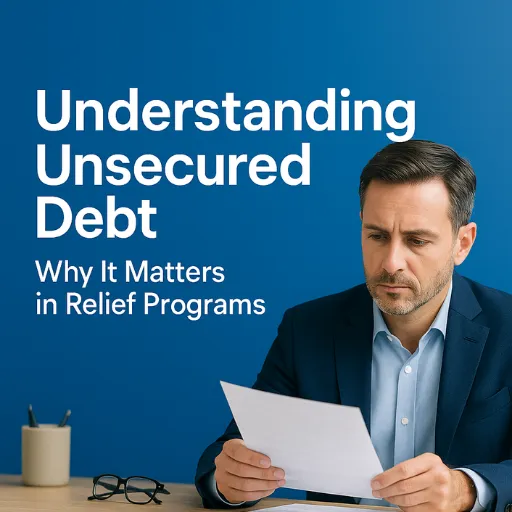
Understanding Unsecured Debt: Why It Matters in Relief Programs
When it comes to choosing the right debt relief option, one of the most important distinctions to understand is whether your debt is secured or unsecured, and that difference can impact everything from your credit score to your eligibility for certain programs.
What Is Unsecured Debt?
Unsecured debt is money you owe that isn’t tied to any collateral. That means the lender can’t repossess a physical item (like your house or car) if you fail to pay.
Common types of unsecured debt:
Credit card balances
Personal loans
Medical bills
Payday loans
Store credit cards
Because there’s no collateral, lenders often charge higher interest rates to reduce their risk, making unsecured debt some of the hardest to get ahead of.
How It Differs from Secured Debt
In contrast, secured debt (like a mortgage or auto loan) is backed by an asset. If you fall behind, the lender can seize the property to recover losses.
Unsecured debt, while less risky for your possessions, can destroy your credit score if ignored, and lead to aggressive collection efforts or lawsuits.
Why It Matters for Debt Relief
Here’s the good news: most debt relief programs are specifically designed for unsecured debt.
Cars lose value rapidly. Many borrowers owe more than the car is worth called being “underwater.”
That includes:
Debt settlement
Debt management plans
Credit counseling
Hardship programs
If you're struggling with unsecured debt over $10,000, you may qualify for custom solutions that reduce what you owe or lower your monthly payments significantly.
Final Thoughts
Unsecured debt might not come with the threat of repossession—but it can still wreak havoc on your finances if left unmanaged. The key is acting before things spiral.
Tip: if your monthly payments feel out of reach, don’t wait. Relief programs are often more effective when you act early.
Ready to See Your Options?
Take 60 seconds to find out if you qualify for a free debt relief plan tailored to your situation.
